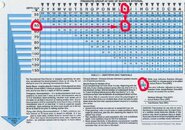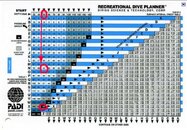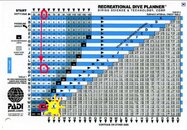Hi there,
I have been looking over these PADI tables again just to keep fresh but I have one burning issue and I know this came up during class but there was a bit of controversy as to what the answer was so I'm bringing it to the table here.
Let's assume I'm repetitive diving. After a dive I have a SIT and end up as a "K" pressure group. I'm planning my next dive to 50 feet. On table 3 it shows that a "K" diver @ 50 feet has an adj. NDL of 44 mins and 36 min RNT. Now does this mean that in order to stay under 44 mins I can only dive for 8 mins (8 + 36 RNT) so as not to exceed the 44 Adj NDL? OR Can I truly dive for up to 44 mins no problem? It seemed like during class our planned ABT + RNT was not to exceed the adj NDL but that didn't seem right. We did it anyway but everyone including the instructors all got confused. I think too many questions were asked.
If I did the dive for 44 mins, then my RNT + ABT would equal 80 mins (TBT) which is greater than the adj NDL of 44. Is that a problem? I can't see a dive only being 8 mins for this pressure group. Also the resulting 80 mins (TBT) is the NDL at 50 ft on table 1.
My thoughts are I can dive for 44 mins max because an 8 min dive is ridiculous for only being a "K" at 50 ft. Please someone confirm that I'm correct here. This has to be right because a "P" diver at 70 ft has a residual greater than the adj NDL which means you wouldn't be able to dive at all if your RNT + ABT couldn't be greater than the adj NDL.
Thanks alot.
I have been looking over these PADI tables again just to keep fresh but I have one burning issue and I know this came up during class but there was a bit of controversy as to what the answer was so I'm bringing it to the table here.
Let's assume I'm repetitive diving. After a dive I have a SIT and end up as a "K" pressure group. I'm planning my next dive to 50 feet. On table 3 it shows that a "K" diver @ 50 feet has an adj. NDL of 44 mins and 36 min RNT. Now does this mean that in order to stay under 44 mins I can only dive for 8 mins (8 + 36 RNT) so as not to exceed the 44 Adj NDL? OR Can I truly dive for up to 44 mins no problem? It seemed like during class our planned ABT + RNT was not to exceed the adj NDL but that didn't seem right. We did it anyway but everyone including the instructors all got confused. I think too many questions were asked.
If I did the dive for 44 mins, then my RNT + ABT would equal 80 mins (TBT) which is greater than the adj NDL of 44. Is that a problem? I can't see a dive only being 8 mins for this pressure group. Also the resulting 80 mins (TBT) is the NDL at 50 ft on table 1.
My thoughts are I can dive for 44 mins max because an 8 min dive is ridiculous for only being a "K" at 50 ft. Please someone confirm that I'm correct here. This has to be right because a "P" diver at 70 ft has a residual greater than the adj NDL which means you wouldn't be able to dive at all if your RNT + ABT couldn't be greater than the adj NDL.
Thanks alot.








